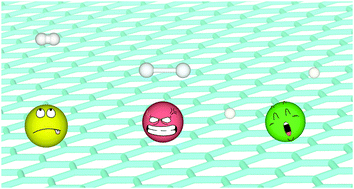当前位置:
X-MOL 学术
›
Phys. Chem. Chem. Phys.
›
论文详情
Our official English website, www.x-mol.net, welcomes your
feedback! (Note: you will need to create a separate account there.)
On the H2 interactions with transition metal adatoms supported on graphene: a systematic density functional study†
Physical Chemistry Chemical Physics ( IF 2.9 ) Pub Date : 2018-01-02 00:00:00 , DOI: 10.1039/c7cp07995h Montserrat Manadé 1, 2, 3, 4 , Francesc Viñes 1, 2, 3, 4 , Adrià Gil 5, 6, 7, 8, 9 , Francesc Illas 1, 2, 3, 4
Physical Chemistry Chemical Physics ( IF 2.9 ) Pub Date : 2018-01-02 00:00:00 , DOI: 10.1039/c7cp07995h Montserrat Manadé 1, 2, 3, 4 , Francesc Viñes 1, 2, 3, 4 , Adrià Gil 5, 6, 7, 8, 9 , Francesc Illas 1, 2, 3, 4
Affiliation

|
The attachment of H2 to the full set of transition metal (TM) adatoms supported on graphene is studied by using density functional theory. Methodology validation calculations on the interactions of H2 with benzene and graphene show that any of the vdW corrections under study, the Grimme D2, D3, D3 with Becke-Jonson damping (D3BJ), and Tkatchenko–Scheffler methods, applied on the PBE functional, are similarly accurate in describing such subtle interactions, with an accuracy of almost 2 kJ mol−1 compared to experiments. The PBE-D3 results show that H2 physisorbs on especially stable d5 or d10 TMs. In other 5d metals, and the rightmost 3d and 4d ones, H2 dissociates, and only for Y, Mn, Fe, and Zr the H2 binds strongly enough for its storage in the so-called Kubas mode, where the H2 bond is sensibly elongated. Other metals (Co, Ni, Ru, Rh and Pd) feature also an elongated Kubas mode, interesting as well for H2 storage. Sc and Ti display a Kubas modes especially suited, given their lightness, for meeting the gravimetric requirements. The H2 interactions with TM adatoms imply a TM → H2 charge transfer, although the magnetic moment of the system tends to remain intact, except for the early 5d TMs, where the unpaired electron transfer seems to be associated with the H2 bond breakage.
中文翻译:

关于H 2与石墨烯上负载的过渡金属原子的相互作用:系统的密度泛函研究†
通过使用密度泛函理论研究了H 2与石墨烯上负载的全套过渡金属(TM)原子的附着。H 2与苯和石墨烯相互作用的方法学验证计算表明,所研究的任何vdW校正,采用Becke-Jonson阻尼(D3BJ)的Grimme D2,D3,D3和Tkatchenko-Scheffler方法均已应用于PBE功能,在描述这种细微的相互作用方面同样准确,与实验相比,准确度几乎为2 kJ mol -1。PBE-D3结果表明,H 2在特别稳定的d 5或d 10 TM上发生物理吸附。在其他5d金属以及最右边的3d和4d金属中,H 2H 2解离,仅对于Y,Mn,Fe和Zr,H 2牢固结合,足以以所谓的Kubas模式存储,在该模式中,H 2键显着延长。其他金属(Co,Ni,Ru,Rh和Pd)也具有细长的Kubas模式,这对于H 2的存储也很有趣。鉴于它们的轻巧性,Sc和Ti显示出特别适合满足重量要求的Kubas模式。H 2与TM原子的相互作用意味着TM→H 2电荷转移,尽管系统的磁矩趋于保持完整,除了5d早期的TMs之外,其中不成对的电子转移似乎与H 2键断裂有关。 。
更新日期:2018-01-02
中文翻译:

关于H 2与石墨烯上负载的过渡金属原子的相互作用:系统的密度泛函研究†
通过使用密度泛函理论研究了H 2与石墨烯上负载的全套过渡金属(TM)原子的附着。H 2与苯和石墨烯相互作用的方法学验证计算表明,所研究的任何vdW校正,采用Becke-Jonson阻尼(D3BJ)的Grimme D2,D3,D3和Tkatchenko-Scheffler方法均已应用于PBE功能,在描述这种细微的相互作用方面同样准确,与实验相比,准确度几乎为2 kJ mol -1。PBE-D3结果表明,H 2在特别稳定的d 5或d 10 TM上发生物理吸附。在其他5d金属以及最右边的3d和4d金属中,H 2H 2解离,仅对于Y,Mn,Fe和Zr,H 2牢固结合,足以以所谓的Kubas模式存储,在该模式中,H 2键显着延长。其他金属(Co,Ni,Ru,Rh和Pd)也具有细长的Kubas模式,这对于H 2的存储也很有趣。鉴于它们的轻巧性,Sc和Ti显示出特别适合满足重量要求的Kubas模式。H 2与TM原子的相互作用意味着TM→H 2电荷转移,尽管系统的磁矩趋于保持完整,除了5d早期的TMs之外,其中不成对的电子转移似乎与H 2键断裂有关。 。









































 京公网安备 11010802027423号
京公网安备 11010802027423号